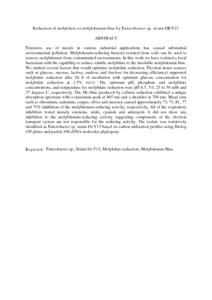Citation
Abd. Shukor , Mohd. Yunus and Shamaan, Nor Aripin and Syed, Mohd. Arif
(2009)
Reduction of molybdate to molybdenum blue by Enterobacter sp. strain DRY13.
Journal of Basic Microbiology, 49 (1).
pp. 43-54.
ISSN 0233-111X
Abstract
Extensive use of metals in various industrial applications has caused substantial environmental pollution. Molybdenum-reducing bacteria isolated from soils can be used to remove molybdenum from contaminated environments. In this work we have isolated a local bacterium with the capability to reduce soluble molybdate to the insoluble molybdenum blue. We studied several factors that would optimize molybdate reduction. Electron donor sources such as glucose, sucrose, lactose, maltose and fructose (in decreasing efficiency) supported molybdate reduction after 24 h of incubation with optimum glucose concentration for molybdate reduction at 1.5% (w/v). The optimum pH, phosphate and molybdate concentrations, and temperature for molybdate reduction were pH 6.5, 5.0, 25 to 50 mM and 37 degrees C, respectively. The Mo-blue produced by cellular reduction exhibited a unique absorption spectrum with a maximum peak at 865 nm and a shoulder at 700 nm. Metal ions such as chromium, cadmium, copper, silver and mercury caused approximately 73, 71, 81, 77 and 78% inhibition of the molybdenum-reducing activity, respectively. All of the respiratory inhibitors tested namely rotenone, azide, cyanide and antimycin A did not show any inhibition to the molybdenum-reducing activity suggesting components of the electron transport system are not responsible for the reducing activity. The isolate was tentatively identified as Enterobacter sp. strain Dr.Y13 based on carbon utilization profiles using Biolog GN plates and partial 16S rDNA molecular phylogeny.
Download File
![[img]](http://psasir.upm.edu.my/16463/1.hassmallThumbnailVersion/Reduction%20of%20molybdate%20to%20molybdenum%20blue%20by%20Enterobacter%20sp.pdf)  Preview |
|
PDF (Abstract)
Reduction of molybdate to molybdenum blue by Enterobacter sp.pdf
Download (85kB)
| Preview
|
|
Additional Metadata
Actions (login required)
 |
View Item |

